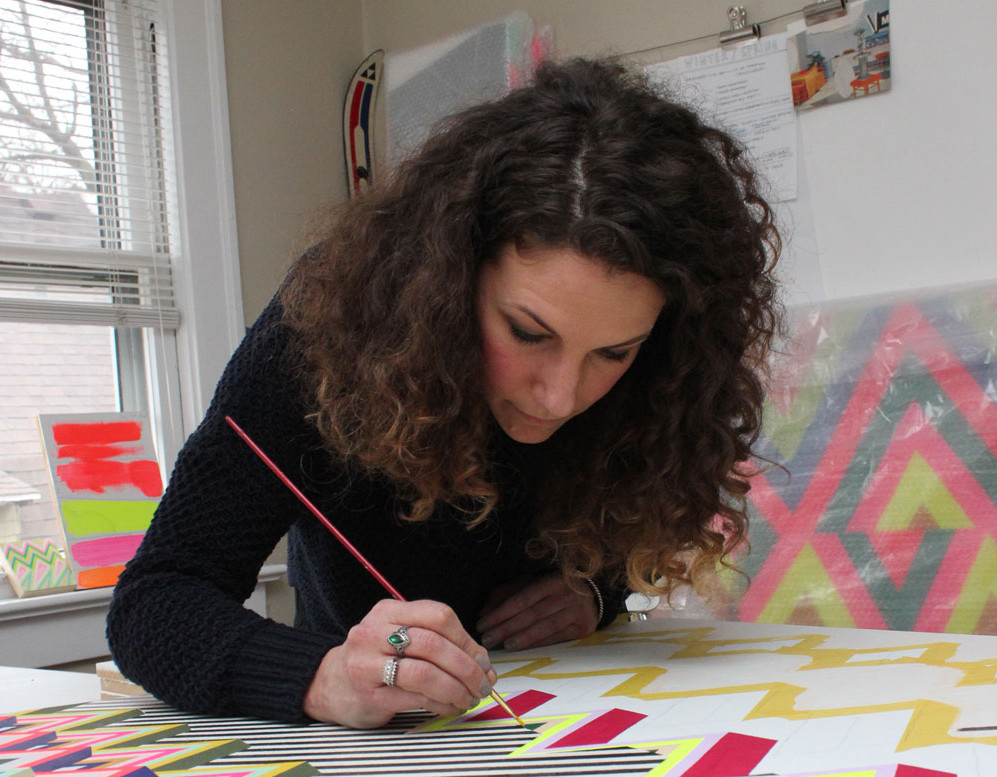Years 26 • Resides & Creates Kent • Learned BFA from New York State College of Ceramics at Alfred University in Alfred, N.Y.
Story and photography by Michael C. Butz
Ella Medicus wants to make you question your surroundings. Her largely sculpture-based practice revolves around manipulating the mundane to toy with your sense of familiarity and challenge your notions of worth and functionality.
Her artistic distortion is aimed at everyday objects ranging from elongated bar codes and Amazon boxes to mechanized plastic grocery bags. Each is recognizable but no longer operational – at least not in their customary way, and that’s the idea.
The objects often take on new meanings. For example, that motor-powered plastic bag moved around a gallery floor and was playfully anthropomorphized by viewers rather than avoided, as a wind-blown plastic bag on the street – similar in appearance – might be.

That’s the type of re-evaluative, perspective-shifting interaction Medicus seeks. In a show on view through May at The Sculpture Center in Cleveland, “SubFunction,” she employs a vending machine filled with snack-like objects to explore themes of worth and the value of art.
“The objects are technically art objects that are being sold out of (the vending machine) because I’ve altered them, and when you think about buying art, there’s a whole realm of who has access to buying art, who’s selling art (and) what are the prices,” she says. “Putting little objects into a vending machine is like saying, ‘Anyone can buy this.’”
In the same show, she uses side-by-side gumball dispensers – one filled with plastic capsules of American soil, the other filled with capsules of soil from Paris, where she recently completed a monthlong residency at the Cité Internationale des Arts – to question Americans’ idealized perceptions of The City of Lights.

“Things from Paris are seen as romantic and special, so I was thinking, ‘How can I talk about that?’” she says. “I was looking a lot at things that were on the ground – the actual soil, litter, things that were discarded – and thinking, ‘What if those things are put on a pedestal instead of the automatic ones, like the Eiffel Tower?’”
Sculpture is the conduit for Medicus’ conceptually nuanced projects but it wasn’t her first medium of interest.
“I thought I was going to be a painter when I went to college, but then I was exposed to sculpture during my schooling and started realizing it made more sense to my mind and I could use objects in different ways,” she says, noting another favored medium is video. “Every project I do is different. When someone asks, ‘What kind of artist are you?’ it’s hard for me to say I’m a sculptor or I’m a video artist because everything is really fluid to me. It really depends on what message I want to have – that’s what determines the medium.”
Process is important to Medicus. She credits conversations with peers – whether her classmates when in school or current artistic collaborator, Eric D. Charlton – with helping her projects take shape. That isn’t to say there haven’t been growing pains. She acknowledges her overall creative process is something to which she’s still adjusting.
“I had a hard time understanding and accepting the way that I work, which is very sporadic. I’ll have an idea or be influenced by something I see, and then things kind of come together,” she says. “I used to think that to be an artist you had to be in your studio laboring away for hours over one thing, and I used to beat myself up about that because I saw a lot of people who did that in school and in life but I could never really make myself do that. And then I realized, ‘OK, I don’t have to do that and can work the way I actually work,’ which is pretty random, and with strange inspiration, suddenly, and then for a while, nothing. (laughs) I’m coming to terms with that.”

If other budding artists are facing similar struggles, Medicus hopes they can follow her example.
“For young artists, if (you) feel stuck in ‘you have to work this one way’ (or) ‘you have to make your work look like it’s made by one person,’ you don’t have to do that. It doesn’t matter. You can do whatever you want – and you should do whatever you want because that’s where something interesting will happen.” C
On View
“Ella Medicus & Eric Charlton: SubFunction” remains on view through May 24 at The Sculpture Center, 1834 E. 123rd St., Cleveland. The show is part of The Sculpture Center’s Window to Sculpture Emerging Artist Series.

“Ella Medicus’ artwork flirts with both humor and the sublime, subtly tweaking mundane objects to unexpected and often hilarious effect. Her work is quiet and initially unassuming, but closer inspection reveals the artist’s subverted sense of humor through mimicry or manipulation of everyday materials.”
Gianna Commito, professor of painting and drawing, Kent State University











